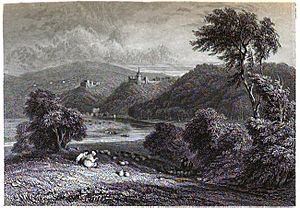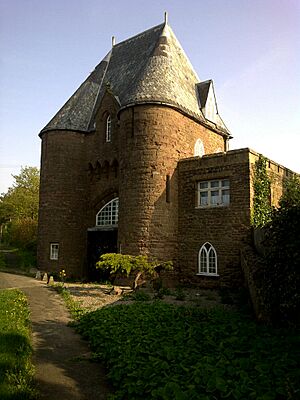Goodrich Court facts for kids
Quick facts for kids Goodrich Court |
|
|---|---|

A Victorian picture of Goodrich Court, with Goodrich Castle visible to the left
|
|
| Type | Castle |
| Location | Goodrich, Herefordshire |
| Built | 1828 |
| Demolished | 1949 |
| Architect | Edward Blore |
| Architectural style(s) | Gothic Revival |
| Lua error in Module:Location_map at line 420: attempt to index field 'wikibase' (a nil value). | |
Goodrich Court was a large, castle-like house built in Goodrich, Herefordshire, England. It was constructed in 1828 by Sir Samuel Rush Meyrick, who was a collector of old and rare items, especially armour. The building was designed by the architect Edward Blore in a style called Gothic Revival, which means it looked like old medieval castles.
The house was described as a "fantastic and enormous tower-bedecked house." It was built on a hill right across from the real Goodrich Castle. This upset the famous poet William Wordsworth so much that he wished he could make the new building disappear!
Sir Samuel Meyrick built Goodrich Court to keep his huge collection of armour and other old objects. Many of these items are now in famous museums like the British Museum and the Wallace Collection. For many years, the house and its collections were a popular stop on the "Wye Tour," a famous trip people took along the River Wye.
After Sir Samuel Meyrick passed away, the Court was owned by several different people. During the Second World War, it was used to house students from Felsted School. After the war, the school left. The building was then emptied of everything inside and completely taken down in 1949–50. Today, only a small gatehouse called the Monmouth Gate and some stables remain.
Building a New Castle: Goodrich Court's Story
Sir Samuel Rush Meyrick loved history, especially Welsh history. He wanted to buy and fix up a real old castle in the Welsh borderlands to be his family home. He even thought about buying Goodrich Castle in 1823, saying it was "the very thing to suit us." But he couldn't buy it.
Instead, he decided to build his own new castle right next to the old ruined one. He called his new home Goodrich Court. The building looked like a huge, tower-filled castle. Because it was built directly opposite the real Norman castle, the poet William Wordsworth called it "impertinent," meaning rude or disrespectful.
After Sir Samuel Meyrick died in 1848, Goodrich Court was bought by George Moffatt, a politician. The Moffatts made the castle even bigger, adding new stables that matched the original style.
During the Second World War, Goodrich Court was used by Felsted School. The school had to move from Essex to escape the war. A former student, Kenneth Kendall, remembered living there. He said the house was full of amazing furniture, paintings, and armour everywhere. He even recalled a funny story about a boy getting stuck inside an old helmet!
When the school moved back after the war, the house was emptied in 1946 and torn down in 1949. The Monmouth Gate, which is on the road to Ross-on-Wye, is the only important part of Goodrich Court that is still standing today.
Goodrich Court's Design and Features
The architect Edward Blore designed Goodrich Court following Sir Samuel Meyrick's ideas. It was built using local red sandstone in the Gothic Revival style. Even though it was based on the old Edwardian architecture seen at Goodrich Castle, some people thought it looked more like a French chateau.
Goodrich Court had many features you'd expect in a castle. It had a gatehouse, a portcullis (a heavy gate that lowers), battlements (the top parts of castle walls with openings for defense), a moat (a ditch around the castle), and towers. One special room was called the Armoury. This large hall held Sir Samuel Meyrick's impressive collection of armour. Many parts of the castle's design used the symbols of Alymer de Valence, an important lord who lived at Goodrich Castle in the early 1300s.
The Monmouth Gate, which is still standing, is made of "red stone with round towers and machicoulis" (openings in the floor of a projecting part of a wall, through which stones or boiling water could be dropped on attackers). It is now a Grade II listed building, meaning it is an important historical building.


